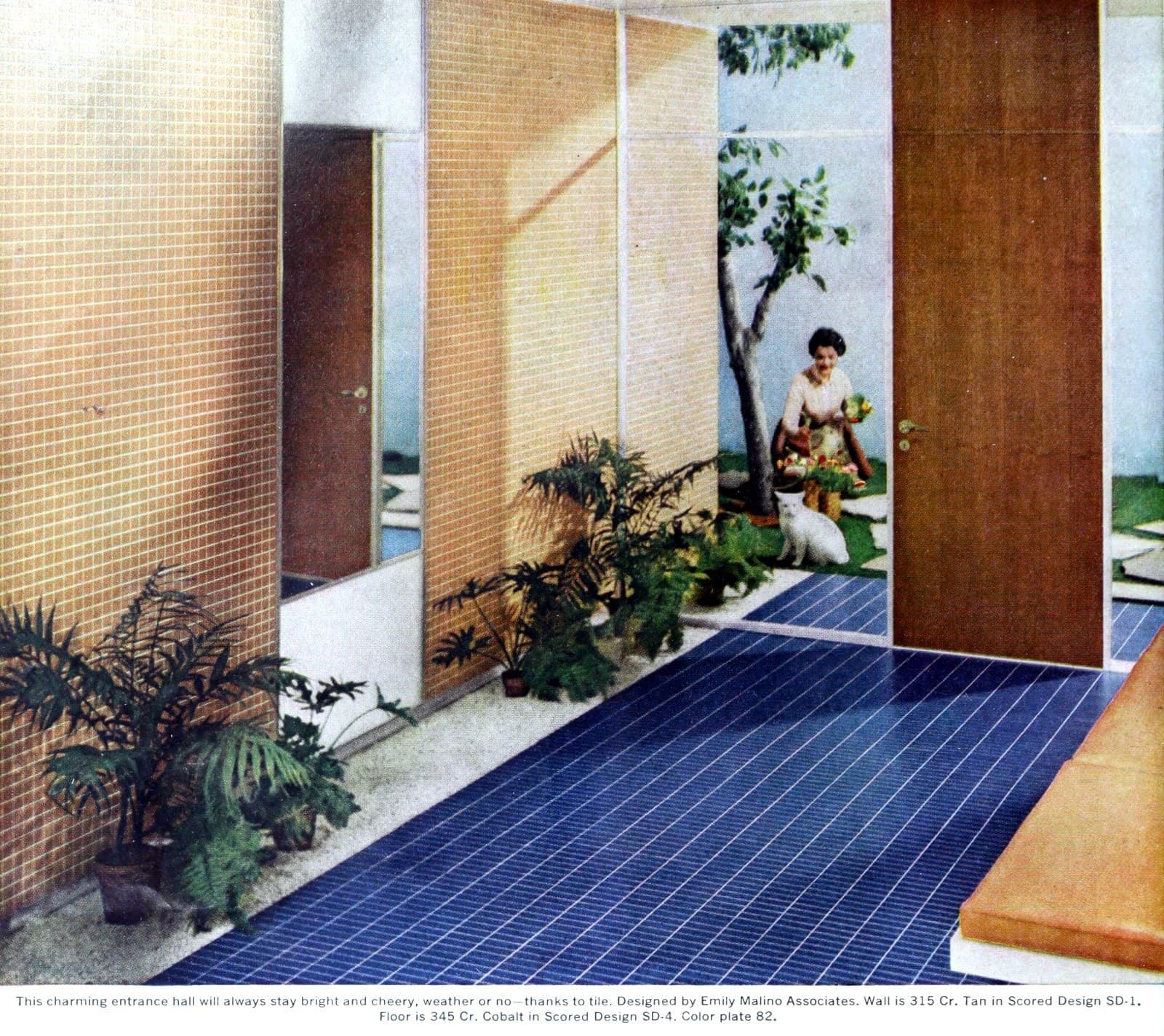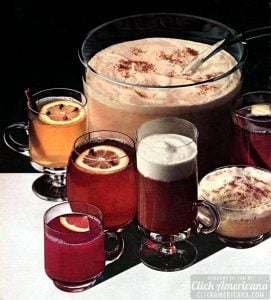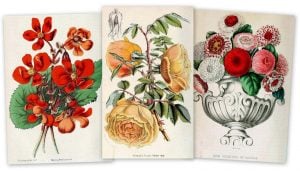Foyers & entrance halls that pay extra dividends (1959)
An entrance hall is the prologue to a house, an introduction that should the rest of your home in focus, and give the visitor a hint of what he will meet in the rooms beyond. Because the hall is your first foot forward, it should be a good one.
If you have a small entrance foyer, there are to make it seem larger. If you are blessed with a large hallway, you can give it a more versatile role as art gallery, library, music room, dining rooms or garden.
If you have no hall at all and your living room suffers from overexposure, you can create a foyer with room dividers and get extra dividends in storage at the same time.
Below, you will find a number of workable ideas for creating a hall that will greet your guests with warmth and style.
DON’T MISS: 22 great vintage kitchen design ideas you don’t see much anymore
1. Hallmark House model home front doors and entry hall (1963)
SEE MORE OF THIS HOME: A mid-century modern show home: See H&G’s Hallmark house for 1963

2. Green and white entryway of the McLean Virginia home of Edward P Morgan (1962)

3. Entry hall floor with a square within a square
Square within square in translucent marbleized and solid green vinyl tiles makes an interesting design for large entry.
Lay out perfect square to contain concentric square, fill out remaining regular or irregular area with border tiles. Number of tiles in each square is determined by floor size.
Translucent vinyl screen, white walls, dark green upholstery, glass, marble and brass accents complete color scheme.

4. Entryway with red accent rug and funky black and white wallpaper (1958)

5. Black metal gate from entry hall into living room
Speaking practically, an entrance hall is a traffic center. Decoratively speaking, it gives guests their first impression of your home.
MORE OF THIS HOME: See the mid-century modern Scholz Mark ’60 model home from 1960, inside & out

6. Parrot green entryway from 1966
On the walls of an entrance hall, Parrot Green, one of H&G’s five new colors for 1967, extends a bright and emphatic welcome.
And the concentration of this tangy new hue, sparked only by black and white, is typical of the opulent one-color look that is becoming increasingly popular for today’s rooms.
Here, the impact of the Parrot Green is varied by the interplay of textures: shiny leather on the benches, patterned cut velvet on the walls, and sculptured wool pile in the rug where it is accented by a strong pattern in Empire Green.
SEE MORE: 50 bold & colorful vintage 1950s home decor ideas, plus authentic mid-century color schemes

7. Elegant marble foyer with carved wooden front door (1964)

8. Retro 1960s wood and blue foyer design and decor (1962)

9. Colorful pottery & a little library in this foyer
Colorful books and pottery in the hallway of designers Harry and Marion Zelenko tell much about their interests.
The hall was created at the entrance to an L-shaped living room by running a man-sized bird cage for the Zelenkos’ flock of finches at right angles to the wall and treating its solid back as another fixed wall. A platform for a plant is cantilevered from the cage.
The deep purple rug makes a splash of color against dark floor… or keep it uncluttered and play up its lines with color.
ALSO SEE: Look back at these vintage bookshelves, book nooks & other beautiful old-fashioned home libraries

10. Foyer floor with open squares in black & yellow
Open squares of marbleized rubber tile set the color key for this entrance hall.
Black and yellow squares of four tiles each are separated by white row one tile wide, with whole design contained in black tooth border. Yellow walls and white trim make normally dark area bright.
The most important feature about a tile floor is that you can lay it yourself. Other features are its availability in a wide range of decorator colors and in a variety of textures: solid color, gold-spattered, marbleized, cork and planking are shown here.
Last, but certainly not least, tile floors are long-wearing and easy to maintain.

11. Checkerboard pattern cork flooring
Checkerboard of vinyl-coated cork tiles in two shades to harmonize with pine paneling covers vestibule and foyer floors.
Start at room’s exact center to lay tiles. Tangerine-colored wall adds warm accent to tiles, paneling and Early American punched tin cabinet.
ALSO SEE: 100+ fabulous ’50s floors of linoleum & vinyl

12. Big blue door and planked flooring for this retro entrance hall
Wide-board planking is re-created with 1/3″ x 3′ vinyl planks in limed oak and teak colors. Work out planking pattern for entire area on paper, start laying floor from center.
To duplicate nail heads, punch peg holes from limed oak, refill with teak.

13. X marks the spot in this entryway
Bold “X” pattern of solid brown vinyl tiles cut into gold-spattered white covers floor of small foyer.
Start center of “X” at the center of the foyer, lay out to ends, then fill in area with white and 4 brown tiles. To harmonize with floor, walls are painted mocha.
MORE: See 125 vintage ’60s home plans used to design & build millions of mid-century houses across America

14. Welcome into the wild blue… entry hall
Bold bands of blue outlining chaste white panels turn the many doors of this hallway into an architectural asset. (You could add half-round molding to plain doors to achieve the same effect.)
The banister and stair carpeting are also blue to introduce the blue and white color scheme that predominates throughout the home of Mr. and Mrs. James Fentress. An old French barometer hangs on the wall in a good spot to alert the weather-wary. Interior designers: Baldwin & Martin.

ALSO SEE: Tour the ultimate mid-century modern house: The Scholz Mark 58 Home of the Year
15. Sunny garden-style entry to this vintage ’60s home
This area also features gold-tone door hardware, a gilded mirror, and a handy telephone nook

16. Simple mid-century modern entrance hall in pastel colors (1957)

17. Create an inviting effect no matter your space
A dramatic vista that terminates in a Jason Schoener painting sets the mood and tempo for the rooms beyond. Translucent paper stretched on a partitioned frame simulates shojis, conceals lights that that on solid wall in the back of it.
Random-width charcoal brick flooring is set loose on a tar paper undersheet and held firm by a wood border which also keeps lighter gray marble chips in place.
The pine-topped cabinet was specially designed and fitted with file drawers for family records — a smart storage idea you might adapt in numerous ways.
Vivid backdrop on end wall is orange Fiberglas. Designed by Steinhardt & Thompson for Midtown Gallery.

18. Foyer turned in an apartment’s small dining area
An intimate dining niche tucks into the entrance of a small apartment. When the meal is adjourned, the square table folds up for safekeeping in a closet, the French dining chairs pull back along the wall, and the hall resumes its other role as the reception area.
Walls are papered in festive gold polka dots on white. Mirror over banquette is from a collection of antique French trumeaux. Interior designer: Catherine Churchill.
ALSO SEE: Post-war housing: See 35 small starter homes from the ’40s & ’50s

19. Entry hall with a curving staircase leading to the living room (1966)
Open stairs match the feel of the open-beam ceiling

20. Greek revival mid-century modern entrance hall
An art gallery installed in the broad central passage of the Edward Marcus home, is an appropriate entrée to a household steeped in the arts.
White wainscoting and trim in the Greek Revival manner and darker-toned walls and ceiling make a flattering background for an extensive collection of mostly modern American paintings.
Lighting for each canvas is directed from swivel lamps mounted on the overhead track. The beautifully-polished bare floor is made of random width planking.

21. Elegant stained wood and classical doorways
MORE: See inside Bing Crosby’s house from 1950 for some classic celebrity style

22. Entrance hall as a library and dining area
A full, equipped bar in the entrance hall of Mr. and Mrs. Milton Kimmelman’s apartment serves both the library at its left, and the dining room at its right.
An Oriental feeling is achieved with ebony-toned wood strips over white grasscloth, brass hardware on the folding doors, brass-scored parquet flooring, and bronze statuary in the far corner.
A translucent ceiling in shoji effect sustains the black-on-white clarity of the room. Designer-architect: Arthur Finn of Finn/Jenter.

23. A tiled mid-century entrance hall with royal blue flooring

24. Make your hall a showplace for your prized possessions
Handcrafted furniture and primitive art collected by Mr. and Mrs. Richard Conte on their travels fill the entrance to their house in Southern California.
Decorated in this very personal manner, the foyer becomes an enticing preview of coming attractions.
Vaulted ceiling and tile floor, typical of the Spanish influence prevalent in the Southwest, make an appropriate background for the collection. Pair of mirrors over chest makes room seem larger. Interior designer: Peter Shore.

25. Lots of sunlight, art, and a stone bench in this mid-century modern entrance hall



















